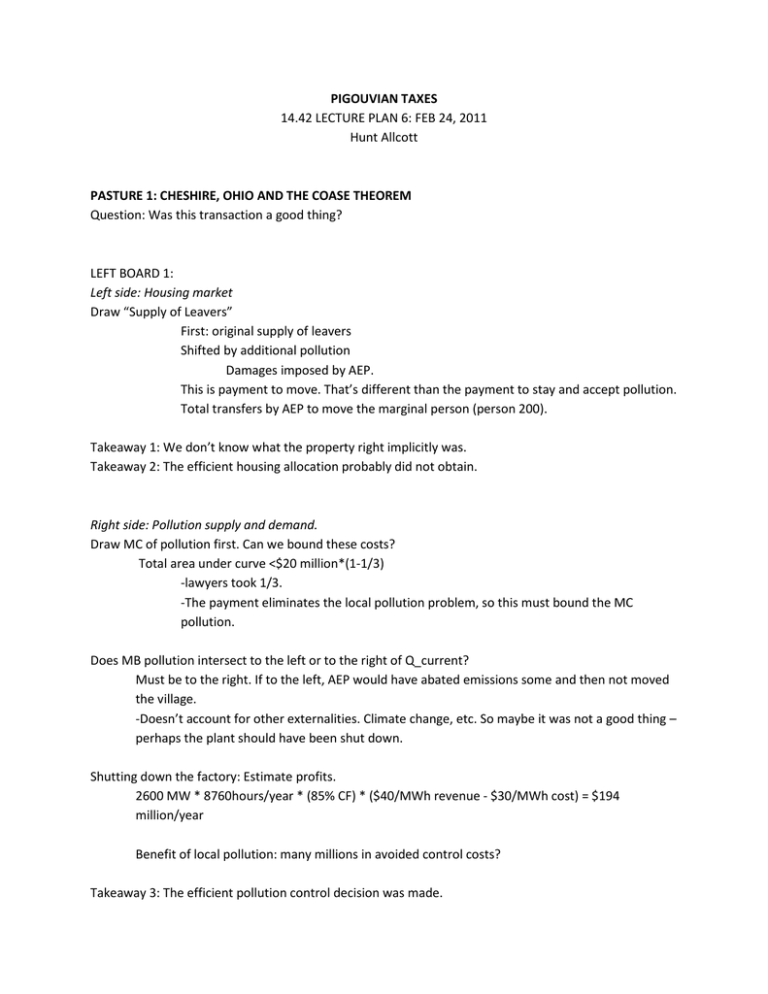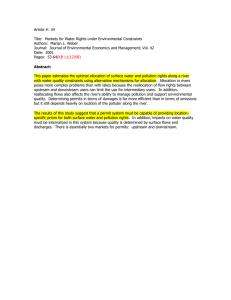PIGOUVIAN TAXES PASTURE 1: CHESHIRE, OHIO AND THE COASE THEOREM Hunt Allcott
advertisement

PIGOUVIAN TAXES 14.42 LECTURE PLAN 6: FEB 24, 2011 Hunt Allcott PASTURE 1: CHESHIRE, OHIO AND THE COASE THEOREM Question: Was this transaction a good thing? LEFT BOARD 1: Left side: Housing market Draw “Supply of Leavers” First: original supply of leavers Shifted by additional pollution Damages imposed by AEP. This is payment to move. That’s different than the payment to stay and accept pollution. Total transfers by AEP to move the marginal person (person 200). Takeaway 1: We don’t know what the property right implicitly was. Takeaway 2: The efficient housing allocation probably did not obtain. Right side: Pollution supply and demand. Draw MC of pollution first. Can we bound these costs? Total area under curve <$20 million*(1-1/3) -lawyers took 1/3. -The payment eliminates the local pollution problem, so this must bound the MC pollution. Does MB pollution intersect to the left or to the right of Q_current? Must be to the right. If to the left, AEP would have abated emissions some and then not moved the village. -Doesn’t account for other externalities. Climate change, etc. So maybe it was not a good thing – perhaps the plant should have been shut down. Shutting down the factory: Estimate profits. 2600 MW * 8760hours/year * (85% CF) * ($40/MWh revenue - $30/MWh cost) = $194 million/year Benefit of local pollution: many millions in avoided control costs? Takeaway 3: The efficient pollution control decision was made. Question: Who should have the property right? There is only damage if people choose to move there: damages caused by a combination of sources and receptors. e.g. What if the power plant were there first? You might say that people moved to Cheshire knowing that they were in the shadow of a power plant. Two common principles: 1. Polluter pays 2. First user has right RIGHT BOARD 1: The Coase Theorem Question: Now imagine that AEP Gavin’s control costs were low, and the efficient outcome would be to install some additional control equipment. Would it matter whether we granted the “right to clean air” to the town or to AEP? First: what does it mean to have the “right to clean air” here in a practical sense? If the polluter had the property right, the local residents could band together and pay the polluter to clean up. Example: Santa Maria feedlot. Alternatively, if the people had the property right, the polluter could pay the residents for some of it. LEFT BOARD 2: Why this doesn’t happen elsewhere Question: what does this depend on? Think about the Cheshire example. Transactions Costs Push question: Why does the Cheshire Transaction not happen more often? Transactions costs. Total surplus has to be more than the transactions costs. Specifically: lawyers’ fees. And the attention it generated for AEP was very negative. This is just weird. Cigarette smoking in restaurants example: it’s tough to pay someone to stop smoking. Question: What kept transactions costs low here? Push Question: Could we do this in a very large town? Small number of people is crucial – fewer lawyers, fewer potential holdouts. Relatively disempowered population: old, not wealthy. Bargaining problems Hold-up e.g. say that the agreement of the entire town were needed. One person could hold it up and demand all of the surplus. Everybody then wants to be that person. Free riders: If the plant had the property right and the residents were going to “buy clean air” (pay for pollution control), how would they figure out how much each person would pay? e.g. say that Gavin has the property right and we want abatement. if pollution worth $100k per person, total pop is 211, and AEP would abate for $20 million. 11 people could in principle refuse to pay and hope that the rest do. But who are those 11? Question: Why does this exist? 1. Because it’s a public good. Pollution is non-rival. If Gavin were producing garbage and could sell it by the bag, it would sell it to local residents up to their MWTP. 2. Because WTP is private information. If it were known, it would be harder for the residents to claim that they weren’t willing to pay $100k. (notice that even if WTP were public, you could still have holdup) Flip to The Coase Theorem slide Why does “price takers mean”? This is about bargaining and hold-up. Why does the no income or wealth effects matter? If you are assigned the rights, your preferences may change. Assignment of rights matters a lot for equity! PASTURE 2: CAP-AND-TRADE RIGHT BOARD 2: Show graphically that tax and cap and trade give the same answer. (Supply and demand for pollution.Draw relatively steep increasing MC (to environment) and flat decreasing MB (firms). They are theoretically equivalent Question: Why do we have quantity regulation? Distributional consequences. Taxes are more commonly not recycled, permit allocations are commonly grandfathered. Weitzman: Prices vs. Quantities Push question: How do we know where to set the price or quantity? Imagine 50% chance of high benefit (i.e. high compliance costs for firms) and 50% chance of low benefit. Draw welfare losses. So quantities are certainly preferred: much smaller welfare losses under quantities? No. LEFT BOARD 3: Continuation of prices vs. quantities Redraw with flatter increasing MC and steeper decreasing MB. MIT OpenCourseWare http://ocw.mit.edu 14.42 / 14.420 Environmental Policy and Economics Spring 2011 For information about citing these materials or our Terms of Use, visit: http://ocw.mit.edu/terms.






